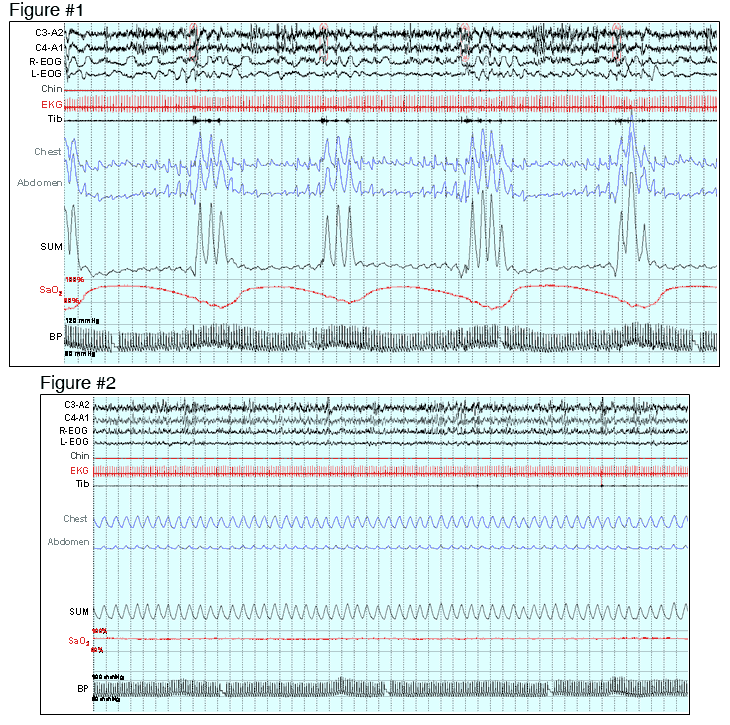Contributed by Stefania Redolfi, MD and T. Douglas Bradley, MD
A 55 year old man with congestive heart failure (CHF) secondary to idiopathic dilated cardiomyopathy was referred for polysomnography (PSG) because of a history of very loud snoring for most of his life, witnessed apneas and excessive daytime sleepiness. He also had a history of atrial fibrillation which resolved on medical therapy prior to being referred. At the time, he was being treated with digoxin, lisinopril, furosemide, coumadin and amiodarone, and his left ventricular ejection fraction (LVEF) was 26%. His body mass index (BMI) was 29 kg/m2. In October 1997, underwent a diagnostic PSG on which he was found to have severe obstructive sleep apnea (OSA) with an apnea-hypopnea index (AHI) of 50 per hr of sleep, accompanied by moderate oxyhemoglobin desaturation (minimum SaO2 = 79%) [Figure 1].
Figure #1/Question #1: A representative 4-minute PSG recording of non-REM sleep of this subject while supine. Thoraco-abdominal movements and tidal volume (SUM) are recorded using calibrated respiratory inductance plethysmography. Finger blood pressure (BP) was measured by digital photoplethysmography (Finapress). Which mechanisms arising from OSA that are apparent on this PSG recording, or present in the patient’s history, might contribute to the development or progression of his CHF?
Figure #2/Question #2: One month later, in November 1997, he underwent a CPAP titration during which OSA was abolished by 9 cmH2O as demonstrated by this representative 4-minute PSG recording of non-REM sleep with the subject supine. What might be the long term outcome of his CPAP therapy and why?
Question #1: Paradoxical (out-of-phase) thoraco-abdominal movements indicate generation of exaggerated negative intrathoracic pressure against the occluded pharynx. This increases left ventricular transmural pressure, and hence afterload. Recurrent apnea-related hypoxia and arousals from sleep increase sympathetic neural outflow, and provoke the surges in blood pressure and heart rate seen on this recording, which further increases afterload. The consequent increase in myocardial oxygen demand is accompanied by a reduction in oxygen supply because of apnea-related hypoxia that could promote myocardial injury, remodeling, cardiac arrhythmias (e.g. atrial fibrillation) and reduced contractility (1).
Question #2: CPAP caused acute abolition of apnea-related hypoxia and surges in blood pressure accompanied by normalization of thoracoabdominal motion, and a reduction in the frequency of arousals, that should have reduced sympathetic activity and afterload. Seven months after initiating CPAP therapy (June 1998), the patient was seen in follow-up and reported a dramatic improvement in exercise tolerance, as well as relief of dyspnea and daytime sleepiness. His LVEF improved from 26% to 39%. His medications and his BMI had not changed since initiation of CPAP. He had 2 reassessment sleep studies, in 1999 and 2005, confirming sustained abolition of OSA on CPAP of 9 cmH2O. On August 2007, after 10 years of CPAP therapy, his LVEF normalized (2), and he was free of symptoms of CHF and OSA.
References:
- Kaneko Y, Floras JS, Usui K, Plante J, Tkacova R, Kubo T, Ando S, Bradley TD. Cardiovascular effects of continuous positive airway pressure in patients with heart failure and obstructive sleep apnea. N Engl J Med 2003;348:1233-1241.
- Leung RS and Bradley TD. Sleep apnea and cardiovascular disease. Am J Respir Crit Care Med. 2001;164(12):2147-65. Review.
- Arzt M and Bradley TD. Treatment of sleep apnea in heart failure. Am J Respir Crit Care Med. 2006;173(12):1300-8. Review.
- Mansfield DR, Gollogly NC, Kaye DM, Richardson M, Bergin P, Naughton MT. Controlled trial of continuous positive airway pressure in obstructive sleep apnea and heart failure. Am J Respir Crit Care Med 2004;169(3):361-6.




